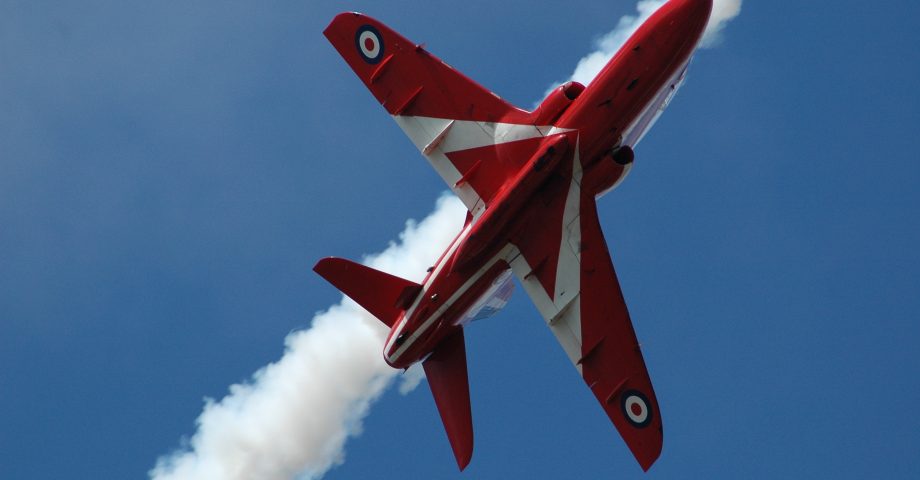The Red Arrows may just be one of the greatest performing aerobatic display teams in the world. Brilliantly showcasing the skills and values of the British Armed Forces, their air shows always look magnificent; it is always a treat for all those watching from below.
Here we are talking about a wonderful slice of British culture and in this article we will be investigating fun facts about The Red Arrows.
1. The Red Arrows have been flying for a long time.
The Red Arrows have been putting on their displays since 1965 and they have flown around an impressive 5,000 displays internationally.
2. They’ve toured all over the world.
The Red Arrows have completed operational tours, including Afghanistan and Libya.
3. They’re actually multicoloured!
They proudly showcase the iconic red version of the BAE Systems Hawk T1 fast-jets, as well as the red, white and blue version.

4. They only started with seven jets.
Originally, the team consisted of seven pilots flying Rolland Gnat T1 jets, until 1968, when the team was increased to nine.
5. Things took a turn in the 80s.
The Gnat was replaced in 1980, bringing on the start of The Red Arrows that we are familiar with today.
6. There’s an RR engine in the jets!
The Red Arrows engine is a Rolls-Royce Mk 151 and it can reach speeds of up to 645 mph at sea level.
7. They never change formation.
The formation the pilots fly in is always the same.
8. They are willing to reduce numbers if illness takes hold.
If a pilot becomes unwell, an eight-person formation will be used instead of the usual nine-person formation.
If the lead pilot is unable to fly, however, the whole performance will be cancelled.
9. The name has a clear purpose.
You may be wondering where their name comes from. RAF training aircraft were mostly painted red in the 1960s and there was a very popular aerobatic team named the ‘Black Arrows’ during the 1950s and early 1960s, so the ‘Red Arrows’ was a tribute to both names.

10. They really load up on dye!
Each of the Red Arrow Hawks carries enough dye to create five minutes of white smoke and one minute of red and blue.
11. One word – a big message!
The Red Arrows have a motto (‘Éclat’) which means ‘Brilliance’.
12. Tragedy struck in 2011.
In 2011 Flt Lt Sean Cunningham was fatally injured.
Flt Lt Sean Cunningham was ejected from one of the jets whilst he was conducting pre-safety checks, but the parachute on the seat failed to deploy.
Martin-Baker Aircraft Ltd, the company that manufactured the seat for the planes, admitted breaching safety laws in 2018 and it was fined £1.1m.

13. The team is based in Lincolnshire.
Since December 21st 2000, The Red Arrows have been based at RAF Scampton, Lincolnshire, England.
14. There’s always a regular changeover.
Every year, three pilots are changed, so the team format is always as follows: three first-year pilots, three second-year pilots and three who are in their final year.
15. Kirsty Moore made history in 2010.
Flt Lt Kirsty Moore was the first female pilot to join the Red Arrows back in 2010.

16. They worked tirelessly in their first year alone!
During the team’s first year, they flew sixty-five displays in the UK and Europe and were awarded the Britannia Trophy by the Royal Aero Club as a tribute to their outstanding contribution to British prestige in the field of aviation.
17. They changed the numbers up occasionally.
In the early days, the displays comprised seven aircraft the majority of the time, but occasionally, nine were used.
18. Bulk really can change when up in the air!
When in flight, the Red Arrow pilot’s body weight can be six times lighter than usual.

19. Some jets have been retired.
The Vulcan bomber, which weighs the same as two train carriages, performed with the Red Arrows for the final time a few summers ago under the call sign ‘Big Big Battle’.
20. The iconic formation emerged in the 60s.
In 1968 – when the team increased from seven to nine – the Red Arrow’s diamond-shaped flying formation, the Diamond Nine, became iconic and was registered as an official trademark.
21. There’s a Red Arrow kit!
CARF Models developed an RC Red Arrow from Skygate in kit form (also available as an ARF). It has a molded fuselage with a 98 in wingspan power and its length is 125 in. The dry weight is around 45 lbs. It needs a 160 to 200 N thrust turbine engine for power.
Also on offer is the Phoenix Model ARF RC Red Arrow, which is made of full wood construction and includes retracts. Its wingspan is 51.2 in and its length is 50.4 in. It needs a 1750 kV motor turning a 90 mm EDF unit producing a minimum of 6 lbs of thrust.

FAQs about The Red Arrows
Do the Red Arrows train during winter?
Yes! They train all year round, and that includes heading into fall and winter, from their RAF base.
How far apart are the Red Arrows while flying in formation?
The Red Arrows are generally around 30 metres apart from each other while flying in formation, though this can extend to 45 metres.
How much does a Red Arrows pilot earn?
A Red Arrows pilot can earn more than $60,000 per year.
Do you have any fun facts about the Red Arrows? Share them in the comments below!
Are you fascinated with all things aviation? Check out these incredible facts about Concorde!










